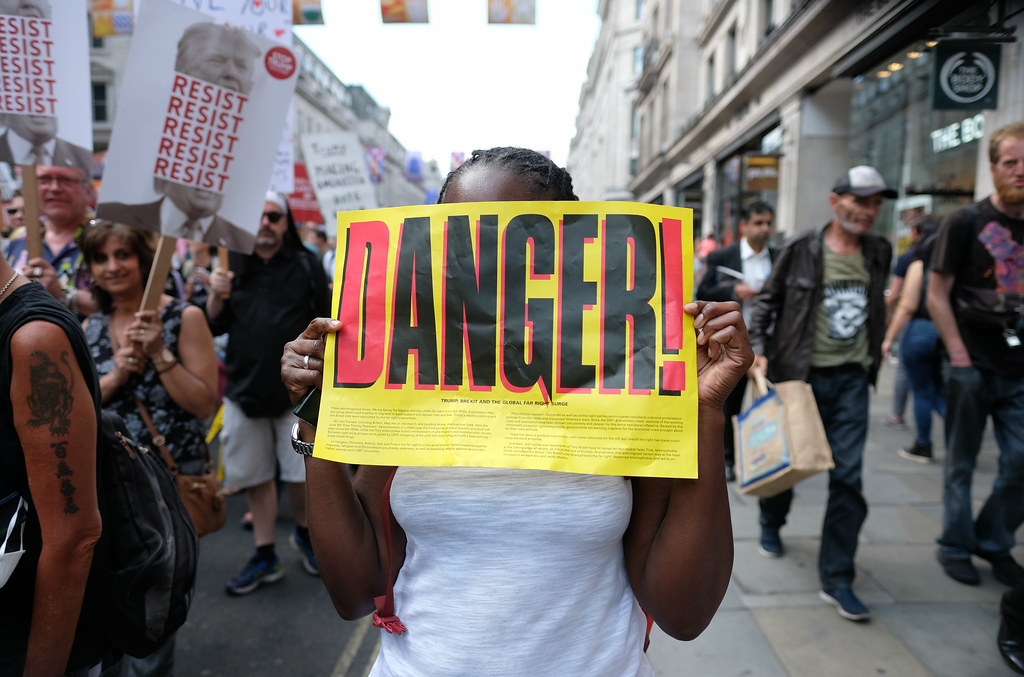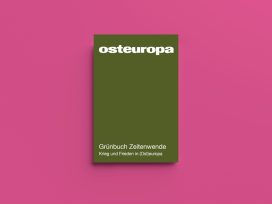Alexander Yanov, the emigré historian of Russia and Russian nationalism, was critical of major western approaches towards post-Soviet Russia in the 1990s. Writing in 1995, he criticized the ‘devious simplicity’ of the western logic holding that, because a non-market Russia had been the West’s sworn enemy, a free-market Russia would become its partner.
We plan to help build a free-market in Russia, yet we have no plan about how to build democracy there. We think that democracy will build itself – as a natural superstructure to the market economy. What if it does not? What if the free market is used as the foundation for an ugly and ominous Russian revanchism – authoritarian, militantly anti-western and anti-democratic?
Yanov compared 1990s Russia, with its new-born democratic institutions and lack of democratic legacy, to Weimar Germany. Challenged by a wide range of anti-democratic groupings, he warned that ‘Weimar Russia’ could collapse and make way for an aggressive ‘red-brown’ state uniting communist and fascist forces.
Yanov’s fears were not unwarranted. In the Duma elections of 1995, the radically anti-western Communist Party of the Russian Federation emerged as Russia’s strongest party, closely followed by the far-right (and misleadingly named) Liberal-Democratic Party of Russia. Yanov was also partially right: the democratic system that Boris Yeltsin had been half-heartedly setting up did collapse in the early 2000s. As we know, what came next was economically capitalist and politically authoritarian. Putin, of course, did not bring the ‘red-brown’ alliance into power. But he used some of its ideas, symbolism and imagery to cement his rule domestically and assert himself internationally.
Could Yanov have imagined that, twenty years later, the country to which he had fled from the USSR in 1974 – the United States of America – could itself be compared with Weimar Germany?

Photo by Alisdare Hickson from Flickr
The analogy does not, of course, originate in debates about Donald Trump’s presidency. There is a long tradition of comparing political phenomena perceived as extremely negative to Europe’s interwar and wartime history – and, by extension, to Nazism and fascism. In the US, such parallels have typically been drawn to demonize the leadership. Since Ronald Reagan, every single American president has at some point been compared to Adolf Hitler. After the September 11 attacks, this became increasingly commonplace.
During the 2004 presidential election campaign, MoveOn, a major public policy advocacy group supporting the Democratic Party, published two political advertisements comparing George W. Bush to Hitler. Jewish groups, including the Simon Wiesenthal Center, the Anti-Defamation League and the American Jewish Congress, sharply criticized the ads, prompting MoveOn to pull them off its website.
Four years later, the conservative journalist Jonah Goldberg published a book entitled Liberal Fascism: The Secret History of the American Left, in which he placed ‘modern liberalism in the family tree of fascism’. Predictably, the book was rubbished by scholars of fascism, though this did not prevent it from becoming a The New York Times bestseller. Goldberg’s idea that Hitler was ‘a man of the left’ seemed to resonate broadly.
The more that liberals and conservatives compared their opponents with ‘Hitler’, corroborating Godwin’s law (just google ‘Bushitler’ or ‘Hitlery’), the more entrenched the view became on both sides that the US was on the verge of becoming a fascist state, or a ‘Weimar America’ about to collapse. Comparisons persisted throughout Obama’s presidency, in connection with austerity, legislative stalemate and the radicalization of the right (e.g. here and here).
Liberal accusations of fascism turned into an avalanche in 2015, when Donald Trump announced his candidacy for the US presidency. In the announcement, Trump made several points that would galvanise his supporters and, for his opponents, confirm the worst. First, he attacked the Affordable Care Act; second, he promised to build a ‘great wall’ on the border with Mexico and get Mexico to pay for it; third, he suggested tightening control over immigration from Latin America and the Middle East.
Columnists Conor Lynch, Jamelle Bouie, Jamil Smith and others bluntly called Trump a fascist. Writing for Newsweek, Jeffrey A. Tucker insisted that fascism was ‘the historically accurate name’ for the ideology Trump espoused. And veteran journalist Roger Cohen ‘welcomed’ his readers to Weimar America on the pages of The New York Times: ‘an angry nation stung by two lost wars, its politics veering to the extremes, its mood vengeful, beset by decades of stagnant real wages for most people, tempted by a strongman who would keep all Muslims out and vows to restore American greatness’. This kind of comparison did not go unchallenged. In an extensive overview, historian Gavriel D. Rosenfeld argued that ‘Nazi analogies may be distorting, rather than deepening, our understanding of contemporary political trends.’
The wrong comparison
In historical terms, it is indeed very difficult to claim that Trump is a fascist or that the US is experiencing a Weimar moment. After all, we don’t need the signifier ‘Weimar’ to describe the collapse of democracy. ‘Weimar’ stand for something more specific: a weak democratic state that replaces an illiberal regime but, failing to gain traction, gives way to another illiberal regime.
It is true that the quality of US democracy has deteriorated in recent years. According to the Economist Intelligence Unit, the USA ceased to be a full-fledged democracy and became a flawed democracy during the Obama presidency. Under Trump, the situation has deteriorated further, though not substantially. However, unlike Weimar Germany or ‘Weimar Russia’, democracy in the USA does not have an undemocratic prehistory. If the former were experiments that failed, democratic backsliding in the USA today is a departure from the norm. Were democracy in the US suddenly to fail, the cause would be anything but the legacy of an illiberal past.
The sense of national humiliation is another important aspect of the ‘Weimar moment’. In the case of Germany, this came with the Treaty of Versailles; for the ‘red-brown’ forces in Russia, the collapse of the Soviet Union was tantamount to Russia’s loss of grandeur. Cohen’s reference to the US as ‘an angry nation stung by two lost wars’ makes little sense. None of the USA’s recent military debacles can be compared to Germany’s defeat in the First World War or to the Soviet Union’s defeat in the Cold War. The absence of a trauma on this scale precludes the rhetoric of a return to the pre-traumatic condition – a further necessary ingredient of the ‘Weimar moment’. If anything, ‘Make America Great Again’ expresses resentment at America’s diminishing status as global hegemon.
To see Trump as a fascist is equally unhistorical. According to the dominant scholarly view, fascism is a form of revolutionary ultra-nationalism. Roger Griffin, a leading exponent of this interpretation, defines ‘fascism’ as ‘a revolutionary species of political modernism originating in the early twentieth century whose mission is to combat the allegedly degenerative forces of contemporary history (decadence) by bringing about an alternative modernity and temporality (a ‘new order’ and a ‘new era’) based on the rebirth, or palingenesis, of the nation.’
Trump is neither a visionary nor a revolutionary; nothing that he does is driven by dreams of a new American civilization arising from the ashes of the degenerate liberal order. If at all, he imagines himself as a keeper of the American tradition; and if he thinks that he wields total authority, then he draws this confidence from the US Constitution rather than the mystical power emanating from the blood of his race.
There is no doubt that Trump is racist. But this is the lazy, default racism born of selfishness, ignorance and privilege, rather than an elaborate world view. It is rather like his sexism, which is hardly an attribute of programmatic masculinity, but rooted in self-indulgence, vanity and turpitude – qualities that real fascism would consider to be constitutive features of liberalism’s permissiveness and moral malaise.
It is also indisputable that Trump’s electoral base includes actual fascists and active racists impressed by his attacks on immigration from Mexico and the Middle East, as well as his earlier association with Steve Bannon. However, they do not consider him as one of their own, not least because of the Jews in his administration. Some fascists see Trump as a proxy for mainstreaming far-right views; others welcome the disorder he brings to American society, believing it will accelerate the collapse of the liberal democratic order and expedite the establishment of a white ethnic state.
Rather than being an American echo of historical European fascisms, Trump is better understood alongside contemporary radical rightwing populisms in Europe. His election victory was greeted by politicians such as Viktor Orbán, Matteo Salvini, Nigel Farage and Marine Le Pen, whose ideology is based on a combination of nativism, authoritarianism and populism. Despite the aversion that western liberals feel towards this combination and its individual elements, the populist radical right is not, as Cas Mudde has put it, ‘alien to the mainstream ideologies of western democracy’. Rather, it ‘constitutes a radicalization of mainstream views’. In contrast to fascists (but also communists and Islamists), radical rightwing populists in Europe do not aspire towards an ‘alternative modernity’. Not only do they operate within the framework of democracy, they also claim that they are the better democrats – an anti-establishment idea resonating with many a disaffected voter, yet repellent to fundamentally anti-democratic fascism.
Antifascism ad absurdum
But while we find no evidence that Trump is a fascist, or that the US is facing a similar fate as the Weimar Republic, the fact that such claims are being made is telling of the zeitgeist. Associated as they are with the crimes against humanity perpetrated in the twentieth century, the terms ‘fascism’ and ‘Nazism’ are used to signify political manifestations of evil, requiring little in terms of explanation. A person, organization or country accused of being fascist is turned into a pariah unworthy of communicating with.
That it can become more than a war of words is borne out by comparison with the Kremlin’s use of the rhetoric of antifasicsm. In March 2014, as the Putin regime was preparing for the annexation of Crimea by staging an illegitimate referendum on secession, billboards featured a choice between a Russian and a ‘fascist’ Crimea. The latter was a reference to the disinformation narrative that the post-Maidan leadership of Ukraine was a ‘fascist junta’. Moscow’s use of fascist analogies in connection with Ukraine has a history. In 2004, fearing that a free election in Ukraine would return a pro-western politician, pro-Kremlin media sought to discredit the democratic opposition as ‘orange fascists’. In order to repel the (largely imaginary) threat of a ‘colour revolution’ in Russia itself, the Kremlin created a ‘movement’ named the ‘Youth Democratic Anti-Fascist Movement “Ours”’.
In Kremlin-speak, the semantics of fascism and antifascism not only differ from the western equivalents, but they are also fluid and contextual. Because the Russian mythology of the ‘Great Patriotic War’ insists that the destruction of Russia was the main aim of the Third Reich and its allies, there is a tendency to interpret any anti-Russian sentiment as fascist. Hence, Ukraine’s pro-western drift was considered fascist, since it was seen to undermine Russia’s position in the post-Soviet space. To be antifascist is to be pro-Russian, if not pro-Kremlin.
So fluid are these semantics that the results can border on the absurd. In 2015, Aleksey Zhuravlyov, a Russian MP and the leader of the pro-Kremlin far-right party ‘Motherland’, referred to Udo Voigt, the former leader of the rightwing-extremist National Democratic Party of Germany, as an ‘antifascist’, on the grounds of Voigt’s support of Moscow’s foreign policy. Likewise, Russian occupation authorities in annexed Crimea had no hesitation in inviting the Belgian far-right activist Kris Roman and the radical rightwing populist politician Gunnar Lindemann (AfD) to take part in the International Anti-Fascist Congress in 2019. Both Roman and Lindemann are known for their ardent pro-Kremlin positions.
But pro-Kremlin propaganda is far from alone in its selective use of the term ‘antifascism’. In both Europe and the US, members of the far-left self-identify as antifascist in order to place their opponents beyond the pale. Fascism is considered a political manifestation of ultimate evil, antifascism the ultimate good. This kind of moral absolutism makes political debate – the cornerstone of democratic culture – impossible.
Moreover, when used to justify violence, antifascism allows rightwing radicals to dismiss and demean the progressive agenda, a goal easily achieved in the echo chambers of social media. This is why the worst possible response to Trump’s permanent goading of Antifa – most notably at the end of May at the height the George Floyd protests – is the uncritical adoption of the label (here one particularly ill-advised example by the chairwoman of the German SPD). The question then becomes whether the ‘ghosts of Weimar’ are not the Left itself, in thrall to a self-fulfilling prophecy.








